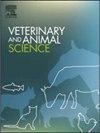Pilot study on the effects of dapagliflozin on echocardiographic parameters in dogs with symptomatic myxomatous mitral valve disease
IF 1.9
Q2 AGRICULTURE, DAIRY & ANIMAL SCIENCE
引用次数: 0
Abstract
Myxomatous mitral valve disease (MMVD) is the most common valvular heart disease in geriatric small-to medium-sized dogs. Dapagliflozin, a sodium-glucose cotransporter-2 inhibitor (SGLT-2i), has shown promise in managing heart failure in human patients. This pilot study aimed to explore the short-term effects of dapagliflozin, when added to conventional therapy in symptomatic MMVD dogs. In a prospective, randomized, single-blind study, five dogs with stage C MMVD received dapagliflozin (0.31 mg/kg, PO, q24h) alongside pimobendan, furosemide, and ramipril. A control group (n = 7) received conventional therapy without dapagliflozin. Echocardiographic, electrocardiographic, blood pressure, blood glucose, NT-proBNP, and urinary glucose data were collected at baseline (D0) and follow-up (D28, D84, and D140). Compared to the control group, dogs receiving dapagliflozin showed significant reductions in the percent change from baseline for left atrial to aortic root ratio, left ventricular internal diameter in diastole normalized to body weight, end-diastolic volume, end-diastolic volume index, end-systolic volume, and end-systolic volume index (P < 0.05). Additionally, ejection fraction significantly increased in the dapagliflozin group (P < 0.05). Glucosuria was consistently present only in the dapagliflozin group. These findings suggest that dapagliflozin, when added to conventional therapy, may promote reverse remodeling and improve cardiac function in dogs with stage C MMVD. Further studies with larger sample sizes and longer follow-up are warranted to validate the cardioprotective effects of dapagliflozin in veterinary patients.

达格列净对症状性二尖瓣黏液瘤病犬超声心动图参数影响的初步研究
二尖瓣黏液瘤病(MMVD)是最常见的心脏瓣膜病在老年小到中型狗。达格列净是一种钠-葡萄糖共转运蛋白-2抑制剂(SGLT-2i),在治疗人类心力衰竭方面显示出前景。这项初步研究旨在探讨达格列净在有症状的MMVD犬的常规治疗中添加的短期效果。在一项前瞻性、随机、单盲研究中,5只患有C期MMVD的狗接受了达格列净(0.31 mg/kg, PO, q24h)和匹莫苯丹、呋塞米和雷米普利的联合治疗。对照组(n = 7)给予不含达格列净的常规治疗。在基线(D0)和随访(D28、D84和D140)收集超声心动图、心电图、血压、血糖、NT-proBNP和尿糖数据。与对照组相比,接受达格列净治疗的狗左心房与主动脉根比、左心室舒张内径与体重、舒张末期容积、舒张末期容积指数、收缩期末期容积和收缩期末期容积指数从基线变化的百分比显著降低(P < 0.05)。此外,达格列净组的射血分数显著升高(P < 0.05)。只有达格列净组持续出现血糖升高。这些发现表明,在常规治疗中加入达格列净可能会促进C期MMVD犬的逆转重构并改善心功能。进一步的研究需要更大的样本量和更长的随访时间来验证达格列净对兽医患者的心脏保护作用。
本文章由计算机程序翻译,如有差异,请以英文原文为准。
求助全文
约1分钟内获得全文
求助全文
来源期刊

Veterinary and Animal Science
Veterinary-Veterinary (all)
CiteScore
3.50
自引率
0.00%
发文量
43
审稿时长
47 days
 求助内容:
求助内容: 应助结果提醒方式:
应助结果提醒方式:


